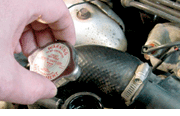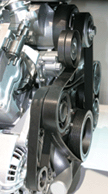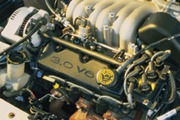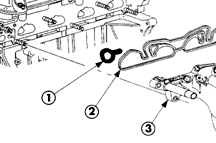Once a cooling system suffers long-term neglect, it turns into an ongoing source of problems for the owner and the service technician because when corrosion starts to take place, the effects cant be reversed. For that single reason, its especially important to understand the Complete Cooling System Service.
Corrosive Effects
The first step to a cooling system check is to look for corrosive influences. Remember, ethylene glycol-based coolants incorporate a considerable additive package thats designed to control the extremely corrosive tendencies of the coolant itself. The additive package not only prevents corrosion, it also prevents electrolysis, which is the tendency of different metals to dissolve and migrate throughout the coolant. This migration is caused by a mild electric current flow that is caused by dissimilar metals being suspended in a water-based liquid. Thus, when the additive package is depleted, critical gasket sealing surfaces become eroded and coolant passage tubes in the radiator become clogged. In addition, sediment caused by rust from iron cylinder blocks settles to the bottom of the engines water jackets, which further decreases the ability of the coolant to dissipate heat.
Once corrosion and electrolysis wreak havoc throughout the cooling system, the future life of the cooling system has been compromised to the point that replacing radiators, heater cores, cylinder head gaskets and other expensive components will become common practice for the owner. As for water pumps, consider that when highly abrasive iron oxides become suspended in the coolant, the life of any new water pump seal becomes severely limited.
Radiator Inspection
 In order to make radiators lighter and more efficient, manufacturers began making the cooling tubes thinner and packing more cooling fins between the tubes. The downsides of such a design, obviously, are cooling tubes that will clog easily and fins that rapidly accumulate road debris. Because of these two factors, water pumps must develop more pressure to circulate coolant, and electric cooling fans must run faster to draw air through denser radiator cores. The objective of any complete cooling system service, of course, is to keep the radiator core as internally and externally clean as possible.
In order to make radiators lighter and more efficient, manufacturers began making the cooling tubes thinner and packing more cooling fins between the tubes. The downsides of such a design, obviously, are cooling tubes that will clog easily and fins that rapidly accumulate road debris. Because of these two factors, water pumps must develop more pressure to circulate coolant, and electric cooling fans must run faster to draw air through denser radiator cores. The objective of any complete cooling system service, of course, is to keep the radiator core as internally and externally clean as possible.
Keep in mind that clogged radiators tend to cause gradual engine overheating, particularly when the vehicle is climbing long gradients over plateaus and high mountain passes. The overheating occurs because a critical number of radiator cooling tubes are clogged. The clogging usually occurs because dirty coolant has been poured back into the radiator after a cooling system component, like a water pump, has been replaced. The clogging may also take place after a severe overheating condition has occurred when sediment from the engine water jackets has been deposited in the radiator core tubes. Although reverse-flushing might remove some of the clogging, I would recommend that the radiator either be replaced or repaired, especially if the overheating condition has reached the severe stage.
Cooling Fans
Like the radiator, electric cooling fan performance is often taken for granted. In reality, modern cooling fan design and operating strategy have become very sophisticated. Some fans are designed as two-speed units, with the low-speed application being used, lets say, 90% of the time. The only time the high-speed application will activate is during high temperatures or high loads.
Consequently, when performing the complete cooling system service, its very important to test the cooling fan for its correct programmed operation. In most applications, the cooling fan will activate when the air conditioning system or compressor clutch is activated. Other applications may require coolant outlet temperatures to rise as high as 230 F before the PCM will command the fan relay to close and activate the cooling fan itself.
Capping it Off: The Theromostat
Several manufacturers have recently issued statements about severe engine damage caused by the effects of sludging and gelling of crankcase oil in their engines. In my experience, when the water condensation is combined with oil and combustion byproducts like carbon and sulfur, the oil thickens into sludge. This sludge accumulates inside the engine and eventually clogs the oil pickup screen and vital lubrication passages.
Gelling, on the other hand, is usually caused by the long-term oxidation of hot oil. As neglected crankcase oil begins to oxidize, it forms a gelatin-like substance that, like sludge, clogs vital lubrication passages in the engine.
Its important to understand that, while sludging or gelling is primarily caused by neglected or unperformed oil changes, it is also aggravated by poorly performing cooling systems. In years past, engines were operated at 195 F in order to better vaporize the fuel and evaporate condensation from the crankcase oil. In direct contrast, some engine designers are now actually running their engines cooler, often at 170-180 F operating temperature, in order to accommodate higher static compression ratios.
Consequently, the role that the ever-so-humble thermostat plays in engine performance and longevity is increasingly important. For example, its important to verify thermostat operation with a non-contact pyrometer and then compare that temperature reading with the OBD II data stream temperature reading. If the temperature readings dont agree or if either of them is out of specification, the engines exhaust emissions, performance, fuel economy and overall operating life will be affected. Considering the relatively low price of a quality, OEM-spec thermostat, its wise to replace the thermostat whenever the cooling system is drained for any other service.
Belts and Hoses
 Clearly, hoses and drive belts are the most under-sold service on todays vehicles, primarily because its not uncommon for many belts and hoses to look like theyre brand-new, even after 60,000-80,000 miles of service. Ideally, new hoses should be sold during a water pump or timing belt replacement. In reality, many service writers and techs take a pass on new hoses to keep the estimate low and avoid the perception of selling unneeded services.
Clearly, hoses and drive belts are the most under-sold service on todays vehicles, primarily because its not uncommon for many belts and hoses to look like theyre brand-new, even after 60,000-80,000 miles of service. Ideally, new hoses should be sold during a water pump or timing belt replacement. In reality, many service writers and techs take a pass on new hoses to keep the estimate low and avoid the perception of selling unneeded services.
Unfortunately, an aging hose or belt usually breaks at the most inconvenient time and location. To make matters more complicated, most heater, throttle body and radiator hoses on modern vehicles (especially imports) are custom-molded, which means that many of these hoses are available only on overnight parts orders.
As for accessory drive belts and timing belts, keep in mind that, depending upon the application, both can drive the all-essential water pump. A failure of the belt means that the vehicle is sidelined until the belt is replaced. Again, serpentine belts are usually application-specific, which means that if the vehicle fails in a rural locality, the driver suffers a major inconvenience.
And finally, electrolysis may be an issue in a cooling system. For more on electrolysis, see the sidebar below.
|
Ford Heater Core Leakage from Electrolysis
The AERA Technical Committee offers the following information that will help you diagnose and repair repeated heater core leakage/failure on 1984-2003 Ford vehicles. This problem has been reported to occur shortly after engine work has been performed. Leaks may be caused by a chemical reaction called electrolysis. Electrolysis involves an ion exchange between the heater core and engine coolant, which may result in a breakdown of heater core material. This is similar to the operation of a battery as it deteriorates. If there is still excessive voltage present in the coolant, check the engine-to-body/battery grounds. Also, verify proper grounding of any aftermarket electrical/electronic equipment. Improperly grounded electrical devices can cause electrolysis to occur. If the condition is still present after checking the grounds, it may be necessary to add extra grounds to the heater core and engine. A hose clamp can be used to secure a 16 AWG stranded copper wire to the heater core inlet tube. The other end should be secured to an existing fastener on the body. Verify continuity of any added grounds to the negative battery terminal. If the condition is still present, add a restrictor (P/N F1UZ-18D406-A) on the inlet hose with the arrow facing toward the heater core. Cut the line and install with two hose clamps. Its important that the restrictor be installed in the right direction of flow and as close to the engine block as possible. |
|
T2s Cooling System Q & A:
Stop That Saturn Engine From Overheating Q: Dear Tomorrows Technician: What could be causing premature Saturn engine failures due to overheating? A: Good question. Heres some information that can be helpful to future underhood technicians and engine builders that can help prevent premature rebuilds due to overheating. The AERA Technical Committee offers the following information on an engine coolant leak on 2000-01 GM 1.9L DOHC engines. These engines are used in the Saturn vehicles made by GM. Vehicles affected are up to and including VIN 1Z305500. Customers may notice a loss of engine coolant, low coolant levels and/or engine overheating. Coolant loss may be due to an intake manifold gasket leak at the coolant passage located behind the number four cylinder intake port, possibly during cold engine operating conditions. To prevent coolant loss, Saturn has revised the intake manifold gasket for those DOHC engines. The new gasket is a two-piece design as shown above consisting of a separate coolant seal (1) that is made of a different material and is black in color and a shortened intake manifold gasket (2) of the same material and orange in color as in the original one-piece design. The manifold is shown as (3). |

 To check for electrolysis, use a DVOM set on DC volts. Place the positive probe of the meter in the engine coolant and the negative probe on the negative battery post. Adjust the engine to 2,000 rpm to allow for coolant flow and electrolysis voltages. If more than 0.2V is recorded, flush the coolant and recheck.
To check for electrolysis, use a DVOM set on DC volts. Place the positive probe of the meter in the engine coolant and the negative probe on the negative battery post. Adjust the engine to 2,000 rpm to allow for coolant flow and electrolysis voltages. If more than 0.2V is recorded, flush the coolant and recheck.

